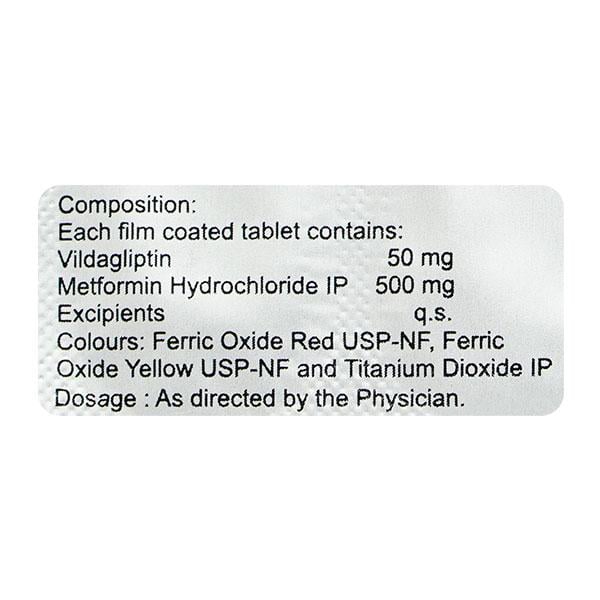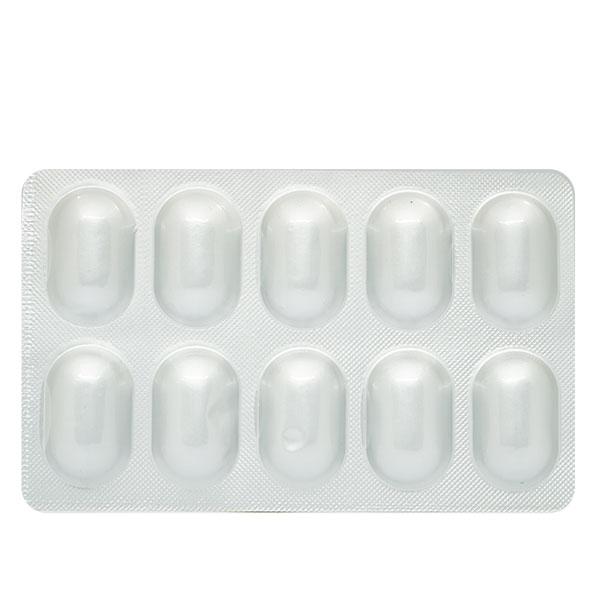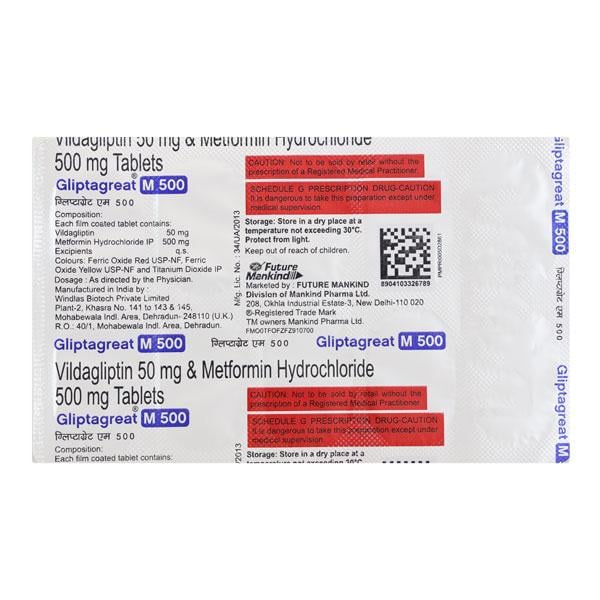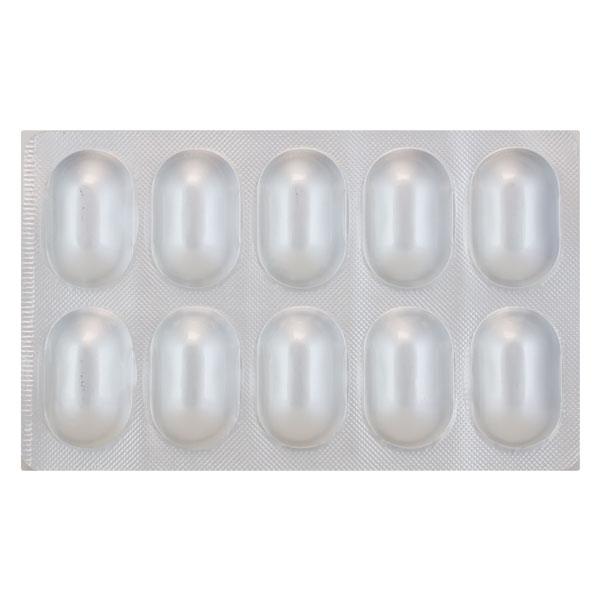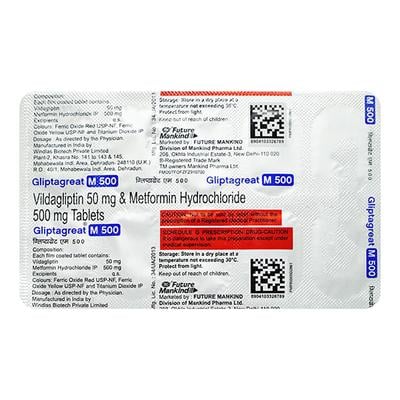

Netmeds First Membership
Quick Links
Introduction About GLIPTAGREAT M 500MG TABLET
Gliptagreat M Tablet is an anti-diabetic oral medication that combines Vildagliptin (a DPP-4 inhibitor) with Metformin (a biguanide) to support balanced blood sugar levels in adults managing type 2 diabetes. This fixed-dose combination is commonly considered when lifestyle changes and monotherapy have not provided adequate control and is usually part of a larger care plan overseen by a healthcare provider. By targeting two different aspects of glucose regulation it supports a smoother glycemic profile throughout the day.
This tablet is particularly suitable for adults with type 2 diabetes mellitus who require additional support in managing post-meal sugar levels and fasting glucose. Vildagliptin helps modulate insulin and glucagon release based on glucose levels, while Metformin improves insulin sensitivity and reduces liver glucose production. This synergistic effect offers a balanced approach to blood sugar regulation and has shown efficacy in studies for improving HbA1c when used appropriately under medical supervision.
Directions for use typically involve taking the tablet with meals to reduce gastrointestinal side effects such as nausea or stomach upset which are most commonly associated with Metformin. It’s important to take the tablet as prescribed-usually once or twice daily and not to skip doses or self-adjust based on sugar readings without consulting a healthcare provider. Patients should ensure adequate hydration and maintain regular meal timing to avoid low blood sugar levels when on combination therapy.
Important precautions include regular monitoring of kidney function and liver enzymes, especially in elderly patients or those with underlying medical conditions. This medicine is not usually recommended during pregnancy or breastfeeding, unless specifically advised by a doctor, due to limited safety data. Commonly reported side effects may include headache, dizziness, gastrointestinal discomfort (bloating, diarrhea), or mild hypoglycemia, especially when combined with other glucose-lowering agents. If you experience unusual fatigue, signs of lactic acidosis, or skin reactions, consult your physician immediately.
Uses Of GLIPTAGREAT M 500MG TABLET
- For managing type 2 diabetes in adults (along with lifestyle changes like heating eating and activity)
Benefits of GLIPTAGREAT M 500MG TABLET
- Supports round-the-clock glucose control: Helps stabilize both fasting and post-meal blood sugar levels
- Enhances insulin sensitivity: Metformin improves how the body processes and responds to glucose.
- Meal-responsive support: Vildagliptin enhances natural hormones that respond after food intake, promoting better metabolic function.
- Helps reduce glucose fluctuations: Supports more consistent blood sugar patterns throughout the day.
- Designed to work alongside lifestyle modifications: Complements dietary changes and physical activity for optimal benefit.
- Assists in long-term metabolic balance: Can contribute to improved HbA1c levels when used regularly.
How GLIPTAGREAT M 500MG TABLET Works
How does Gliptagreat M tablet regulate blood glucose
Gliptagreat M Tablet is a dual-ingredient oral medication that helps the body manage blood glucose levels more effectively, especially in adults diagnosed with type 2 diabetes. It combines Vildagliptin, a DPP-4 enzyme inhibitor, and Metformin, a commonly prescribed insulin sensitizer. Together, these agents work through different biological pathways to support better glucose balance throughout the day.
- Vildagliptin works by enhancing the natural hormones (incretins) that signal the pancreas to release insulin only when needed—usually after meals—while reducing the hormone glucagon, which raises blood sugar.
- Metformin complements this action by reducing the liver’s glucose production and increasing the uptake of sugar by the muscles and tissues.
This combination allows Gliptagreat M to help stabilize both fasting and post-meal glucose levels, making it a valuable part of a broader glucose management plan when used consistently and under medical supervision.
Gliptagreat M tablet how it supports metabolic control
Beyond blood sugar balance, Gliptagreat M Tablet contributes to improved overall metabolic health, which includes how efficiently the body processes and uses energy. This is particularly important in individuals managing type 2 diabetes, where insulin function and sugar metabolism are often disrupted.
- Metformin plays a central role in improving how the body responds to insulin, helping tissues absorb glucose more efficiently.
- Vildagliptin adds metabolic support by fine-tuning hormonal responses during digestion, which reduces unnecessary sugar fluctuations after eating.
By targeting key aspects of glucose regulation and insulin sensitivity, Gliptagreat M helps reduce variability in sugar levels and may support better long-term outcomes when combined with personalized nutrition, physical activity, and regular follow-up. This integrated metabolic support makes it a helpful option in structured diabetes care strategies.
How to use GLIPTAGREAT M 500MG TABLET
Recommended Dosage and Timing for Gliptagreat M
- Dosage is individualized based on blood glucose levels, kidney function, and overall response.
- Commonly prescribed once or twice daily depending on therapeutic needs.
- Healthcare providers may adjust dosage based on lab values (e.g., HbA1c) and patient response.
- Do not exceed the prescribed dose or skip doses without professional advice.
- Regular follow-up is important for dose reassessment and treatment monitoring.
When should I take Gliptagreat M before or after food
- It is generally recommended to take Gliptagreat M with meals.
- Taking the tablet with food can:
- Help improve absorption.
- Minimize stomach discomfort and nausea (associated with Metformin).
- Aim for consistent timing with main meals (e.g., breakfast and/or dinner).
- If you miss a meal, consult your healthcare provider on how to proceed with the dose.
Gliptagreat M Administration Instructions:
- Swallow the tablet whole with water—do not chew, crush, or break it.
- Take it at the same time(s) each day for better blood sugar stability.
- Maintain proper hydration and continue dietary and lifestyle recommendations alongside.
What if I forgot to take GLIPTAGREAT M 500MG TABLET
If you accidentally miss a dose of Gliptagreat M Tablet, take it as soon as you remember—preferably with food if it's around your regular mealtime. However, if it is almost time for your next scheduled dose, skip the missed one and continue with your usual dosing routine. Do not take two doses at once to make up for the missed tablet, as this may increase the risk of side effects such as dizziness, weakness, or low blood sugar. Consistency in timing and dosage helps the medicine work more effectively. If you frequently miss doses, it may be helpful to set a daily reminder or use a medication tracker.
Overdose
Taking more than the recommended dose of Gliptagreat M Tablet can increase the risk of adverse effects, especially those related to Metformin such as lactic acid build-up (a rare but serious condition) or excessive lowering of blood sugar levels. Symptoms of overdosage may include nausea, vomiting, stomach discomfort, fatigue, or unusual drowsiness. In such cases, seek immediate medical attention. Do not attempt to self-correct or delay professional care. Always keep this medication out of reach of children and do not share it with others, even if their symptoms appear similar.
Side Effects Of GLIPTAGREAT M 500MG TABLET
Common Side Effects of GLIPTAGREAT M 500MG TABLET:
- diarrhea
- stomach pain
- loss of appetite
- metallic taste
- low blood glucose
- joint pain, tiredness
- constipation
- swollen hands, ankles, or feet (oedema)
When to Seek Medical Attention?
Stop taking GLIPTAGREAT M 500MG TABLET and contact your doctor immediately if you experience any of the following side effects:
- symptoms of lactic acidosis (such as vomiting, stomach pain, decreased heartbeat, difficulty breathing, muscle cramps, general weakness with severe tiredness, or reduced body temperature)
How To Manage Side Effects
Constipation
- Increase your daily water intake to soften stools.
- Include fiber-rich foods such as fruits, vegetables, and whole grains in your diet.
- Engage in regular physical activity to promote bowel movements.
- Avoid excessive use of laxatives unless recommended by a healthcare professional.
- Consult your doctor if constipation lasts more than a week or worsens.
Diarrhea
- Take Gliptagreat M with meals to reduce gastrointestinal irritation.
- Drink plenty of fluids to prevent dehydration.
- Avoid caffeine, alcohol, and high-fat foods that can worsen diarrhea.
- Consume probiotic-rich foods like yogurt to help restore gut bacteria balance.
- If diarrhea persists beyond a few days, contact your healthcare provider.
Stomach Pain
- Take the tablet with food to minimize stomach discomfort.
- Eat smaller, more frequent meals rather than large meals.
- Avoid spicy, greasy, or acidic foods that may irritate the stomach.
- Use a warm compress on the abdomen for relief if needed.
- Inform your doctor if pain is severe or persistent.
Warning & Precautions
Pregnancy
Monitoring requiredGLIPTAGREAT M 500MG TABLET is not recommended for pregnant women unless it is considered necessary.
Breastfeeding
ContraindicatedGLIPTAGREAT M 500MG TABLET is not recommended for use by breastfeeding women.
Driving and Using Machines
Use with CautionDo not drive or operate any machines if you experience dizziness after taking GLIPTAGREAT M 500MG TABLET.
Alcohol
Consult your doctorConsumption of alcohol is not recommended during management with GLIPTAGREAT M 500MG TABLET since it may increase the risk of lactic acidosis.
Kidney
ContraindicatedGLIPTAGREAT M 500MG TABLET is not recommended in patients with severely reduced kidney function.
Liver
ContraindicatedGLIPTAGREAT M 500MG TABLET is not recommended in patients with liver disease.
Allergy
ContraindicatedDo not take GLIPTAGREAT M 500MG TABLET if you are allergic (hypersensitive) to Metformin, Vildagliptin or any other ingredients of this medicine.
Heart Disease
ContraindicatedGLIPTAGREAT M 500MG TABLET is not recommended in patients who recently had a heart attack or heart failure or any signs of heart problems such as serious blood circulation problems or difficulty breathing.
Use In Pediatrics
ContraindicatedGLIPTAGREAT M 500MG TABLET is not recommended for use in children and adolescents less than 18 years of age due to a lack of safety and effectiveness.
Use In Geriatrics
Use with CautionGLIPTAGREAT M 500MG TABLET should be used with caution in elderly patients above 65 years of age, especially in patients with impaired kidney function. Your doctor will adjust the dose depending on kidney function, and your kidney function will be monitored regularly.
Other Warnings for GLIPTAGREAT M 500MG TABLET
Before taking GLIPTAGREAT M 500MG TABLET, inform your doctor if you have or had:
- pancreatic disease
- Vitamin B12 deficiency
- Malnutrition with adrenal or pituitary insufficiency
Who should not take [GBNKEYWORD
GLIPTAGREAT M 500MG TABLET is not recommended for you if you have:
- Type 1 diabetes mellitus
- Uncontrolled diabetes
- Severe infection or seriously dehydrated
- are going to have a contrast x-ray (a specific type of x-ray involving an injectable dye)
Safety Advice
Safety Measures and Monitoring During Gliptagreat M Use
When using Gliptagreat M Tablet, it’s important to follow safety measures and regular monitoring to ensure the medication works effectively and safely. Before starting the medicine, inform your healthcare provider about any existing medical conditions, especially kidney or liver problems. Routine blood tests are recommended to check kidney function and blood glucose levels periodically. Always take Gliptagreat M exactly as prescribed, typically with meals, to minimize side effects like stomach discomfort. Report any unusual symptoms such as persistent nausea, weakness, or breathing difficulties promptly to your doctor. Regular monitoring helps your healthcare provider adjust the dose if needed and maintain optimal metabolic control.
Gliptagreat M lactic acidosis risk
Lactic acidosis is a rare but serious condition linked primarily to the Metformin component in Gliptagreat M. It occurs when lactic acid builds up in the blood faster than it can be removed. Symptoms may include muscle pain, severe weakness, trouble breathing, dizziness or unusual sleepiness. Although very uncommon, the risk increases in people with impaired kidney function, liver problems, dehydration or severe infections. To reduce this risk, it is important to have regular kidney function tests and avoid situations that may cause dehydration or illness without medical advice. If you experience any symptoms suggestive of lactic acidosis, seek medical attention immediately. Always follow your healthcare provider’s instructions closely to minimize this risk.
Diet and Lifestyle Advice
- Maintain a balanced diet with whole grains, lean proteins, vegetables, and low glycemic index fruits to support stable blood sugar levels.
- Eat meals regularly and take Gliptagreat M with food to reduce side effects and enhance effectiveness. Avoid skipping meals.
- Stay well-hydrated by drinking plenty of water throughout the day to support kidney function and metabolism.
- Incorporate regular physical activity, aiming for at least 30 minutes of moderate exercise most days (e.g., walking, cycling, swimming).
- Monitor and maintain a healthy weight to improve blood sugar control and overall metabolic health.
- Avoid tobacco use and limit alcohol consumption as they can interfere with medication effectiveness and increase health risks.
- Attend regular health check-ups to monitor blood sugar levels, kidney function, and overall progress while using Gliptagreat M.
- Manage stress through techniques such as meditation, yoga, or deep breathing, as stress can affect blood sugar levels.
- Maintain a consistent routine by taking medication at the same time daily and following a regular meal and exercise schedule.
Gliptagreat M vs Janumet
|
Feature |
Gliptagreat M (Vildagliptin + Metformin) |
Janumet (Sitagliptin + Metformin) |
|
Active Ingredients |
Vildagliptin + Metformin |
Sitagliptin + Metformin |
|
Mechanism of Action |
Vildagliptin enhances insulin secretion; Metformin reduces glucose production in liver |
Sitagliptin enhances insulin secretion; Metformin reduces glucose production in liver |
|
Indication |
Type 2 diabetes management |
Type 2 diabetes management |
|
Dosage Form |
Tablet |
Tablet |
|
Common Dosage Strengths |
50mg/500mg, 50mg/1000mg |
50mg/500mg, 50mg/1000mg |
|
Frequency |
Usually twice daily |
Usually twice daily |
|
Side Effects |
GI upset, headache, dizziness, rare lactic acidosis |
GI upset, headache, nasopharyngitis, rare lactic acidosis |
|
Risk of Hypoglycemia |
Low when used alone, higher if combined with other meds |
Low when used alone, higher if combined with other meds |
|
Kidney Precautions |
Requires monitoring; dose adjustment in renal impairment |
Requires monitoring; dose adjustment in renal impairment |
|
Pregnancy Category |
Use only if benefits outweigh risks |
Use only if benefits outweigh risks |
|
Weight Impact |
Weight neutral or modest loss |
Weight neutral or modest loss |
|
Availability |
Widely available in many countries |
Widely available globally |
|
Additional Notes |
Vildagliptin not approved in all countries; some reports of skin reactions |
Sitagliptin widely used, established safety profile |
Drug - Drug interaction
When using Gliptagreat M Tablet, it’s important to be aware that it may interact with other medicines, potentially affecting how well it works or increasing the chance of side effects. Always inform your healthcare provider about all the medications, supplements, or herbal products you are taking to ensure safe and effective use.
1. Diuretics (e.g., furosemide, thiazides):
Interaction: May increase the risk of low blood sugar or dehydration, affecting glucose control.
Management: Monitor blood sugar levels closely; your doctor may adjust your Gliptagreat M dose or recommend hydration strategies.
2. Corticosteroids (e.g., prednisone):
Interaction: Can raise blood sugar levels, reducing Gliptagreat M’s effectiveness.
Management: Regular blood sugar monitoring; dosage adjustment might be necessary during steroid therapy.
3. Beta-blockers (e.g., atenolol, metoprolol):
Interaction: May mask symptoms of low blood sugar, making it harder to recognize.
Management: Patients should monitor blood sugar more frequently and be cautious of signs like dizziness or sweating.
4. Other glucose-lowering agents (e.g., sulfonylureas, insulin):
Interaction: Higher risk of blood sugar dips (hypoglycemia).
Management: Close monitoring of blood glucose; dose adjustments of one or more medicines may be required.
5. Iodinated contrast agents (used in some imaging tests):
Interaction: Risk of kidney problems increases, affecting Metformin clearance.
Management: Inform your doctor before imaging; Metformin may need to be temporarily stopped.
Drug - Food interaction
When taking Gliptagreat M Tablet, certain foods and beverages can influence how the medication works or increase the risk of side effects. Being aware of these interactions helps maintain effective blood sugar management and reduces unwanted reactions. Always follow your healthcare provider’s advice regarding diet while on this medicine.
1. Alcohol:
Interaction: Can increase the risk of low blood sugar and a rare condition called lactic acidosis related to Metformin.
Management: Avoid or limit alcohol consumption; discuss safe limits with your doctor.
2. High-carbohydrate meals or sugary foods:
Interaction: Can cause blood sugar spikes, making glucose control harder even with medication.
Management: Follow a balanced diet with consistent carbohydrate intake to support medication effects.
3. Foods high in fiber:
Interaction: May slow down the absorption of Metformin, reducing its effectiveness temporarily.
Management: Maintain a balanced intake of fiber, and take medication as advised (usually with meals).
Synopsis
|
Drug |
: |
Metformin, Vildagliptin |
|
Pharmacological Category |
: |
Biguanides, Dipeptidyl peptidase 4 inhibitors |
|
Therapeutic Indication |
: |
Type II diabetes mellitus |
|
Dosage Forms |
: |
Tablet |
More Information
Storage
- Keep GLIPTAGREAT M 500MG TABLET out of reach of children
- Do not store above 30°C
FAQs About GLIPTAGREAT M 500MG TABLET
Q: What is Gliptagreat M Tablet used for?
A: Gliptagreat M Tablet combines Vildagliptin and Metformin to help manage blood sugar levels in adults with type 2 diabetes. It supports glucose regulation by enhancing natural insulin response and reducing sugar production in the liver. It is typically prescribed when lifestyle changes and single medications are not sufficient for blood sugar control.
Q: Who should take Gliptagreat M Tablet?
A: Gliptagreat M is generally prescribed for adults diagnosed with type 2 diabetes who need improved blood sugar control beyond diet and exercise alone. It is often used when Metformin alone does not achieve target blood sugar levels, under strict medical supervision.
Q: Can I take Gliptagreat M Tablet on an empty stomach?
A: It is recommended to take Gliptagreat M with meals to reduce the risk of gastrointestinal side effects such as nausea or diarrhea. Food helps improve the medication’s tolerance and supports steady blood sugar control.
Q: Can Gliptagreat M cause low blood sugar?
A: While Gliptagreat M has a lower risk of causing low blood sugar compared to some other diabetes medications, it can still occur, especially if combined with other glucose-lowering drugs or if meals are skipped. Recognize symptoms like sweating, shaking, or confusion and seek advice promptly.
Q: Are there any serious side effects I should watch for?
A: Rarely, Gliptagreat M can cause lactic acidosis, a serious condition marked by muscle pain, breathing difficulty, and fatigue. Also, report any signs of allergic reactions like rash or swelling immediately. Regular monitoring helps minimize these risks.
Q: Can I take Gliptagreat M if I have kidney problems?
A: Gliptagreat M should be used cautiously in patients with kidney impairment. Kidney function tests are essential before and during treatment. Your doctor may adjust the dose or recommend alternative therapies based on your kidney health.
Q: Is Gliptagreat M safe during pregnancy?
A: Gliptagreat M is generally not recommended during pregnancy unless specifically advised by your doctor. Managing blood sugar during pregnancy requires close supervision, and alternative medications may be preferred.
Q: How long does it take for Gliptagreat M to show effects?
A: Blood sugar improvements may be noticed within a few days to weeks, but optimal benefits often take several weeks of consistent use combined with lifestyle changes. Regular monitoring by your doctor will track progress.
Q: Can Gliptagreat M cause weight gain?
A: Gliptagreat M is less likely to cause weight gain compared to some diabetes medications. In fact, Metformin often helps with modest weight loss or maintenance when combined with diet and exercise.
Q: What precautions should I take while using Gliptagreat M?
A: Follow your doctor’s instructions carefully, attend regular check-ups, maintain kidney function tests, and report any unusual symptoms. Avoid dehydration and inform your healthcare provider about all other medications or supplements you take.
Q: What should I avoid while taking Gliptagreat M?
A: Avoid skipping meals, excessive alcohol, and medications that may interfere with blood sugar control without consulting your doctor. Also, avoid sudden changes in physical activity without professional advice.
Q: What should I avoid while taking Gliptagreat M?
A: Avoid skipping meals, excessive alcohol, and medications that may interfere with blood sugar control without consulting your doctor. Also, avoid sudden changes in physical activity without professional advice.
Q: Can Gliptagreat M cause gastrointestinal problems?
A: Some people experience mild gastrointestinal symptoms like nausea, diarrhea, or abdominal discomfort, especially when starting the medication. These usually improve over time.
Q: Does Gliptagreat M affect kidney function?
A: Gliptagreat M is processed partly through the kidneys, so regular kidney function tests are essential to prevent complications. Dose adjustments may be needed if kidney function declines.
Q: Can I stop Gliptagreat M suddenly?
A: Do not stop taking Gliptagreat M without consulting your healthcare provider. Sudden discontinuation can lead to uncontrolled blood sugar levels.
Q: Does Gliptagreat M require blood sugar monitoring?
A: Yes, regular blood sugar monitoring is essential to track the medication’s effectiveness and prevent complications like hypoglycemia or hyperglycemia.
Q: How does exercise affect Gliptagreat M use?
A: Regular exercise can improve the effectiveness of Gliptagreat M by increasing insulin sensitivity. However, sudden intense activity without adjusting medication or food intake can increase hypoglycemia risk.
Q: Can Gliptagreat M cause vitamin B12 deficiency?
A: Metformin, one component of Gliptagreat M, has been associated with reduced vitamin B12 absorption over long periods. Regular monitoring and supplementation may be advised.
Q: What happens if I eat irregularly while on Gliptagreat M?
A: Irregular meals can cause blood sugar fluctuations and increase the risk of low blood sugar episodes. Consistent meal timing is important.
References
1. KD Tripathi MD. Hormones and related drugs. Essentials of Medical Pharmacology. Seventh edition. New Delhi, May 2013. Page-274.
2. Paresh Ved and Samrat Shah. Evaluation of vildagliptin and fixed dose combination of vildagliptin and metformin on glycemic control and insulin dose over 3 months in patients with type 2 diabetes mellitus. March 2012. [Accessed on 29th May 2025] ![]()
3. Serge Halimi, Anja Schweizer, Biljana Minic, James Foley and Sylvie Dejage. Combination treatment in the management of type 2 diabetes: focus on vildagliptin and metformin as a single tablet. March 2008. [Accessed on 29th May 2025] 
4. Novartis Pharma GmbH. Electronic Medicines Compendium (EMC) [Revised in August 2021] [Accessed on 29th May 2025] 
5. Cipla Ltd. VYSOV-M Tablets (Vildagliptin + Metformin hydrochloride). [Revised in July 2020] [Accessed on 29th May 2025] 










